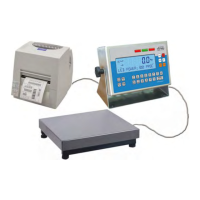Why do my RADWAG WPW/E switch off automatically?
- JJoshua HesterJul 31, 2025
Your RADWAG Scales may be switching off automatically because the 't1' parameter is set to 'YES' for power saving. To resolve this, navigate to and change to 'NO'.

Why do my RADWAG WPW/E switch off automatically?
Your RADWAG Scales may be switching off automatically because the 't1' parameter is set to 'YES' for power saving. To resolve this, navigate to and change to 'NO'.
What to do if my RADWAG WPW/E display 'LH'?
If your RADWAG Scales are displaying 'LH', it means the weight pan was not empty when the device was switched on. Remove any load from the pan to return the indication to zero.
| Category | Scales |
|---|---|
| Manufacturer | RADWAG |
| Model | WPW/E |
| Readability | 0.1 g |
| Display | LCD |
| Interface | RS232 |
| Power supply | AC adapter |
| Protection class | IP |
Emphasizes reading the manual, using the device as intended, and proper disposal of equipment.
Covers SLA accumulator specifications, charging, power failure handling, and replacement guidelines.
Advises connecting the device to earthing when operating in strong electrostatic fields.
Details specific cleaning instructions for scales, including caution for washing agents and water jets.
Provides a table outlining allowed cleaning methods (detergent, water jet, hot water) for various scale types.
Explains the meaning of different battery charge pictogram states (charging, full, low, blinking).
Explains how to use the keyboard keys to browse and navigate through the scale's menu system.
Explains how to save or skip changes and return to the main weighing screen.
Lists precautions for accurate measurements, such as placing loads carefully, centrally, and avoiding concentrated force.
Describes how to zero the scale using the ZERO key and the conditions for zeroing within ±2% of full scale.
Details how to set the basic unit and toggle between different weight units like kg, lb, oz, etc.
Explains how to adjust the filtering level, noting higher levels increase stabilization time.
Details how to set appropriate parameters for the tare function, including modes like NORMAL, MEMORY, SUM.
Explains the autozero function for precise indications and its auto-correction capability, with advisories for specific scenarios.
Lists parameters for RS232/RS485 settings: baud rate, data bits, stop bit, and parity.
Lists default Ethernet parameters and provides configuration guidance for network setup.
Explains how WPW scales can cooperate with computers and the EDYTOR WPW software for configuration and data management.
Explains the use of barcode scanners for quick assortment database searches and configuration.
Details the procedure for setting the time, including entering hour and minute values.
Explains how to set the AUTO. PRINT parameter to define printout behavior (manual, automatic, continuous).
Guides users on how to design and create their own non-standard printout formats.
Lists available variables (e.g., mass, date, time, thresholds, statistics) that can be used in printouts across all modes.
Explains the process for operators to log in by entering a password or using a transponder card.
Describes how administrators can set three levels of access for editing databases: administrator, advanced operator, operator.
Explains how users can search databases using criteria like code, name, or record number.
Details the capacity and procedure for defining operators in the database.
Guides on entering the report editing mode and selecting parameters for filtering reports.
Lists connectable external buttons (TARE, PRINT, ZERO, START, STOP) and how to assign functions to them.
Details the procedure for deleting existing statistics to start a new measurement series.
Explains the POWER SAVE function, which switches off the device after 5 minutes of inactivity.
Details the calibration procedure, including unloading the pan, adjusting start mass, placing calibration weight, and factor adjustment.
Explains how to assign different functions to specific keys for easier access to functionalities.
Introduces the standard software procedure for counting pieces and the initial step of taring the package.
Explains how the software helps control deviations in percent from a standard (nominal) mass.
Introduces the dosing function, its capabilities, and cautions regarding continuous printouts and inductive loads.
Introduces the labelling system for marking goods, printing standard, cumulative, and cumulative-of-cumulative labels.
Presents the Ethernet module PCB and lists its connectors and associated modules.
Introduces the WE 8 module for expanding inputs/outputs and its capabilities, with cautions.
Introduces the DP1 module for adding an extra platform and shows its PCB.
Lists commands (Z, T, OT, UT, S, SI, etc.) for RS interfaces and their descriptions.
Lists technical specifications for WPW/E scales, covering various capacities and IP ratings.
Provides guidelines for RADWAG scales to communicate with barcode scanners using RS232.
Introduces the EDYTOR WPW software for scale supervision, parameter editing, and data management.
Explains how to design labels using EDYTOR ETYKIET R02, including adding text and variables.